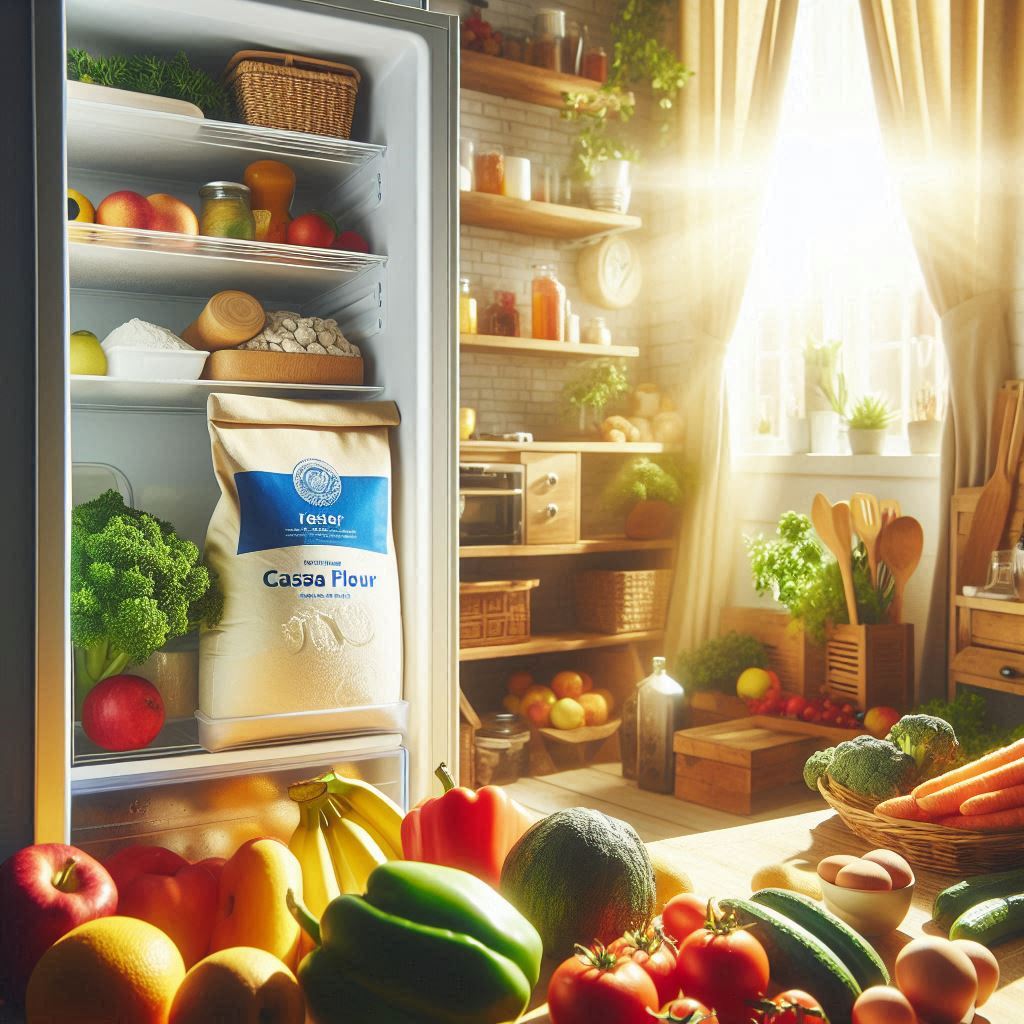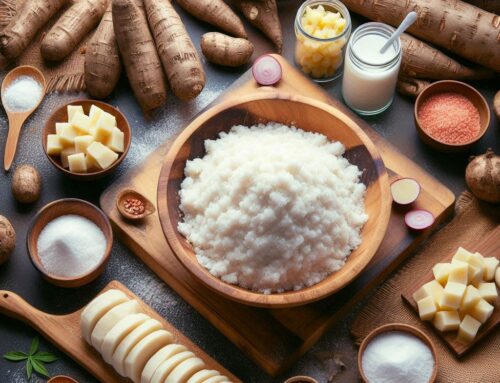
Understanding Cassava Flour: What Makes It Unique?
Cassava flour has been gaining attention as a versatile and unique gluten-free alternative for baking and cooking. Derived from the root of the cassava plant, this flour stands out due to its distinct properties that make it an excellent choice for those seeking gluten-free options. One of the primary cassava flour properties is its ability to mimic the texture and consistency of wheat flour, which can be challenging to achieve with other gluten-free flours. This makes it an ideal substitute in recipes that require a similar texture to traditional baked goods.
A common point of confusion arises when comparing cassava flour vs. tapioca starch, as both are derived from the same plant. However, their processing methods differ significantly; while cassava flour is made by grating and drying the whole root, tapioca starch is extracted through a more refined process that isolates only the starchy part of the root. This distinction gives cassava flour a higher fiber content and more nutritional value compared to tapioca starch.
Incorporating cassava flour into your culinary repertoire can open up new possibilities for creative cooking without compromising on taste or texture. Whether you’re making bread, pancakes, or cookies, understanding these unique attributes allows you to leverage its full potential in your kitchen endeavors.
The Shelf Life of Cassava Flour: How Long Does it Last?
Cassava flour has gained popularity as a versatile, gluten-free alternative to traditional wheat flour. However, like all food products, it has a shelf life that should be considered to ensure optimal freshness and quality. Understanding the shelf life of cassava flour and how to store it properly can help you make the most of this valuable ingredient.
Typically, the shelf life of cassava flour ranges from six months to a year when stored under ideal conditions. To maximize its longevity, cassava flour should be kept in an airtight container in a cool, dry place away from direct sunlight. This helps prevent moisture absorption and protects against pests.
For those looking to extend the shelf life even further, refrigeration or freezing is an effective option. When stored in the refrigerator or freezer, cassava flour can last up to two years without losing its quality. Be sure to use airtight containers or heavy-duty freezer bags for storage to prevent any moisture from seeping in.
By following these storage tips for preserving cassava flour, you can ensure it remains fresh and ready for your culinary adventures whenever you need it.
The Science Behind Freezing Foods: How Does It Affect Ingredients?
Freezing is a time-tested method for preserving food, but have you ever wondered about the science behind it? At its core, freezing involves lowering the temperature of food to halt the activity of microorganisms and enzymes that cause spoilage. This process effectively extends the shelf life of various ingredients while maintaining their edibility.
One of the primary benefits highlighted in freezing food science is its ability to preserve nutrients. When done correctly, freezing can retain vitamins and minerals better than some other preservation methods like canning or drying. However, it’s crucial to freeze foods quickly to prevent large ice crystals from forming, which can damage cell structures and affect texture.
The effects of freezing on food quality also depend on how well foods are packaged before being frozen. Proper packaging reduces exposure to air and prevents freezer burn—a condition that results in dry spots and off-flavors due to moisture loss. By understanding these scientific principles, you can maximize both nutrient retention and overall quality when storing your favorite ingredients in the freezer.
Freezing Cassava Flour: Pros and Cons According to Experts
Freezing cassava flour has become a topic of interest for many looking to preserve this versatile ingredient. Understanding the advantages and disadvantages can help you make informed decisions about storage.
One of the primary advantages of freezing cassava flour is its extended shelf life. Experts note that freezing can significantly slow down the degradation process, keeping the flour fresh for longer periods. This method also helps in maintaining its nutritional value and flavor, which is crucial for those who use cassava flour regularly in their cooking.
On the downside, some experts caution that freezing flours, including cassava, may lead to changes in texture once thawed. This can affect the consistency of your recipes if not managed properly. Additionally, improper sealing before freezing might expose the flour to moisture, leading to clumping or spoilage.
Overall, expert opinions on cassava storage suggest that while freezing offers notable benefits in terms of longevity and preservation, it requires careful handling to avoid potential drawbacks. Proper packaging and understanding how thawing affects your recipes are key considerations when opting for this storage method.
Alternative Storage Methods for Cassava Flour to Maximize Freshness
Cassava flour is a versatile and gluten-free alternative to traditional wheat flour, but like all flours, it requires proper storage to maintain its freshness and quality. One of the best ways to store cassava flour is by using airtight containers. These containers prevent moisture and air from seeping in, which can cause the flour to spoil or become stale. Glass or BPA-free plastic containers with tight-fitting lids are ideal choices for this purpose.
It’s also important to store cassava flour in a cool, dry place away from direct sunlight. A pantry or cupboard that maintains a stable temperature is perfect for keeping your flour fresh without the need for freezing. If you purchase cassava flour in bulk, consider dividing it into smaller portions that can be sealed individually. This not only helps preserve freshness but also makes daily use more convenient.
By following these simple yet effective storage methods, you can ensure that your cassava flour remains fresh and ready for use whenever you need it, without relying on refrigeration or freezing techniques.
User Experiences: What Do Home Bakers Say About Freezing Cassava Flour?
When it comes to home baking, the storage of ingredients can significantly impact the final product. Cassava flour, known for its gluten-free properties and versatility, is a popular choice among bakers. However, questions often arise about the best ways to store it for optimal freshness and usability. Many home bakers have turned to freezing as a solution, and their experiences provide valuable insights into this practice.
Baker experiences with frozen cassava flour generally highlight its effectiveness in maintaining freshness over extended periods. Freezing cassava flour helps prevent spoilage and keeps pests at bay, which is particularly beneficial in warmer climates where pantry storage may not suffice. Many bakers report no noticeable difference in texture or taste when using frozen cassava flour compared to its freshly stored counterpart.
Community tips on storing flours often emphasize the importance of airtight containers when freezing cassava flour. By sealing the flour tightly before placing it in the freezer, bakers ensure that moisture does not affect its quality. Additionally, labeling containers with dates helps track how long the flour has been stored.
Real-life storage solutions for bakers also suggest portioning out cassava flour into smaller bags or containers before freezing. This approach allows home bakers to thaw only what they need for each recipe, minimizing waste and maintaining quality throughout multiple uses.
Overall, freezing appears to be a practical method embraced by many in the baking community for preserving cassava flour’s integrity while extending its shelf life. By following these shared experiences and tips from fellow bakers, you can confidently incorporate frozen cassava flour into your culinary creations without compromising on quality or flavor.
Conclusion: Making the Right Choice for Your Needs and Recipes
When it comes to selecting the right ingredients and tools for your culinary adventures, making informed decisions is key to achieving the best results. Whether you are a seasoned chef or an enthusiastic home cook, understanding your specific needs and the requirements of your recipes can make all the difference.
Consider what you want to achieve with each dish. Are you aiming for a quick weeknight meal or an elaborate dinner party masterpiece? Your choice of ingredients should align with these goals. Fresh, high-quality produce can elevate simple dishes, while specialty items might be necessary for more complex recipes.
Additionally, think about dietary preferences and restrictions. With a growing number of options available in grocery stores today, it’s easier than ever to adapt traditional recipes to suit vegan, gluten-free, or other dietary needs without compromising on flavor.
Finally, don’t underestimate the importance of kitchen tools. Investing in quality equipment can streamline your cooking process and improve overall results. From sharp knives to reliable cookware, having the right tools at hand ensures that you’re well-prepared for any culinary challenge.
By carefully considering these factors—your goals, ingredient quality, dietary needs, and kitchen equipment—you can confidently make choices that enhance both your cooking experience and the delicious outcomes on your plate.






